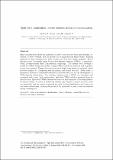| dc.contributor.author | Bouma, Andrew Thomas | |
| dc.contributor.author | Lienhard, John H. | |
| dc.date.accessioned | 2018-09-07T19:18:41Z | |
| dc.date.available | 2018-09-07T19:18:41Z | |
| dc.date.issued | 2018-08 | |
| dc.date.submitted | 2018-07 | |
| dc.identifier.issn | 0011-9164 | |
| dc.identifier.uri | http://hdl.handle.net/1721.1/117682 | |
| dc.description.abstract | Brine concentration allows for increased recovery ratios in water treatment systems, reduction of waste volumes, and the production of minerals from saline brines. Existing methods of brine concentration, while robust, are often very energy intensive. Better efficiency may be possible using Counterflow Reverse Osmosis (CFRO), a membrane-based, pressure-driven brine concentration technology. The present work develops a model for CFRO. Using this model, a single CFRO module is simulated and its performance characterized. Exergy destruction within a single-stage system is analyzed, which provides insights for configuring and optimizing multistaged systems. Additionally, a parametric analysis of membrane parameters provides direction for the development of CFRO-specific membranes. Two existing configurations of CFRO are discussed, and compared with a new third configuration, split-feed CFRO, which is presented here for the first time. Split-feed CFRO systems are simulated and optimized to provide guidance for system design. A variety of multistage systems operating at a range of recovery ratios are simulated, and the results compared are with existing desalination and brine concentration technologies, showing the potential for improved recovery ratios and reduced energy consumption. Keywords: Brine concentration, Desalination, Energy efficiency, Counterflow reverse osmosis, Zero liquid discharge | en_US |
| dc.description.sponsorship | Kuwait Foundation for the Advancement of Sciences | en_US |
| dc.language.iso | en_US | |
| dc.publisher | Elsevier | en_US |
| dc.relation.isversionof | https://doi.org/10.1016/j.desal.2018.07.011 | en_US |
| dc.rights | Creative Commons Attribution-Noncommercial-Share Alike | en_US |
| dc.rights.uri | http://creativecommons.org/licenses/by-nc-sa/4.0/ | en_US |
| dc.source | Prof. Lienhard | en_US |
| dc.title | Split-feed counterflow reverse osmosis for brine concentration | en_US |
| dc.type | Article | en_US |
| dc.identifier.citation | Bouma, Andrew T., and John H. Lienhard. “Split-Feed Counterflow Reverse Osmosis for Brine Concentration.” Desalination, vol. 445, Nov. 2018, pp. 280–91. | en_US |
| dc.contributor.department | Massachusetts Institute of Technology. Department of Mechanical Engineering | en_US |
| dc.contributor.mitauthor | Bouma, Andrew Thomas | |
| dc.contributor.mitauthor | Lienhard, John H. | |
| dc.relation.journal | Desalination | en_US |
| dc.eprint.version | Author's final manuscript | en_US |
| dc.type.uri | http://purl.org/eprint/type/JournalArticle | en_US |
| eprint.status | http://purl.org/eprint/status/PeerReviewed | en_US |
| dspace.orderedauthors | Bouma, Andrew T.; Lienhard, John H. | en_US |
| dspace.embargo.terms | N | en_US |
| dc.identifier.orcid | https://orcid.org/0000-0002-6420-9677 | |
| dc.identifier.orcid | https://orcid.org/0000-0002-2901-0638 | |
| mit.license | OPEN_ACCESS_POLICY | en_US |
